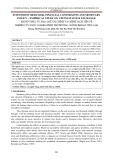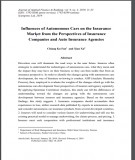
Tightening monetary policy
-
Using the data-set of 200 non-financial companies listed on HOSE and HNX for the period 2007 - 2016, this paper examines the effect of bank financing on corporate investment behavior and the extent to which bank financing affects corporate investment behavior in different monetary policy periods. By applying GMM method, the results find that company with more bank financing will reduce the proportion of investment, and in comparison with the period of loosening monetary policy, company tend to reduce its investments by bank loans in the period of tightening monetary policy.
 12p
12p  vijihyo2711
vijihyo2711
 25-09-2021
25-09-2021
 12
12
 1
1
 Download
Download
-
Using the financial data of A-share listed companies in 2003-2018, this paper studies the maturity mismatch of investment and financing in China based on the sensitivity of investment to change of short-term loans. This study finds that corporate investment relies on short-term loans rather than long-term loans, so the maturity mismatch of investment and financing is widespread. In addition, we examine the mechanism of the heterogeneity between state-owned enterprises and private enterprises.
 1p
1p  chauchaungayxua2
chauchaungayxua2
 19-01-2020
19-01-2020
 11
11
 2
2
 Download
Download
-
With regard to the interest rate environment, we expect that the ECB will continue to raise key rates in the near future. There are several reasons why the ECB will tighten policy somewhat. One is that inflation has remained above the target for a long time, albeit moderately, and in the recent survey reported by the ECB inflation forecasts were raised slightly compared to the previous one. Also, the monetary overhang, which the ECB interprets as one leading indicator for future inflation, increased further due to persistently high money growth.
 33p
33p  hoangphiyeah1tv
hoangphiyeah1tv
 18-04-2013
18-04-2013
 59
59
 6
6
 Download
Download
-
Bulgaria’s difficult transition from plan to market was marked by persistent macroeconomic and financial instability leading to a major economic collapse in 1996-1997. In 1997 a currency board arrangement (CBA) was established as a “policy of last resort” with the aim to impose fiscal and financial discipline. The change in the monetary regime was accompanied by a comprehensive package of policy reforms affecting not only the macroeconomic but also the institutional environment and the functioning of the financial system.
 36p
36p  enterroi
enterroi
 01-02-2013
01-02-2013
 52
52
 3
3
 Download
Download
-
The international dimensions of credit growth pose specific policy challenges (Borio et al (2011)). First, in economies experiencing booms, international credit often complicates the job of domestic authorities who seek to monitor and to constrain credit. For example, domestic authorities have several tools to slow the growth of credit extended by banks within their jurisdiction. But short of capital controls, the tools to measure, much less to control, credit extended by institutions outside the country are limited.
 12p
12p  enter1cai
enter1cai
 12-01-2013
12-01-2013
 47
47
 3
3
 Download
Download
-
A third consecutive year of 8%-plus growth was led by strong expansion of investment and consumption. The rapid growth has strained resources, as shown by a surge in imports, infrastructure bottlenecks, skilled-labor shortages, and inflation, which accelerated to over 19% year on year by March 2008. The authorities have tightened monetary policy and allowed some exchange rate flexibility to rein in price rises, and are initiating fiscal measures. These steps, plus weaker external demand, should pull back growth this year. In 2009, inflation is expected to moderate and GDP growth pick up.
 7p
7p  nv_tien
nv_tien
 20-03-2009
20-03-2009
 353
353
 81
81
 Download
Download
CHỦ ĐỀ BẠN MUỐN TÌM



















